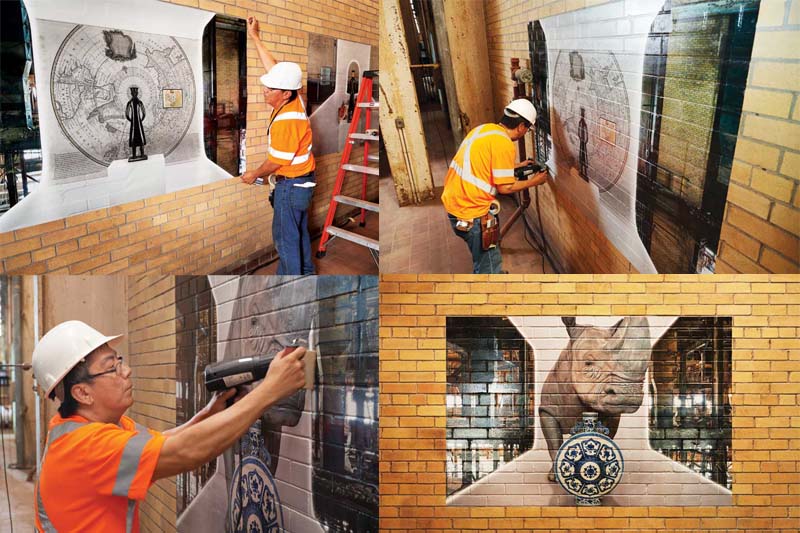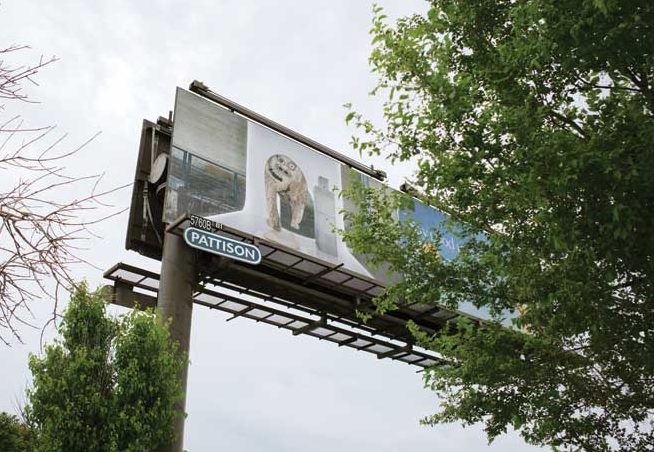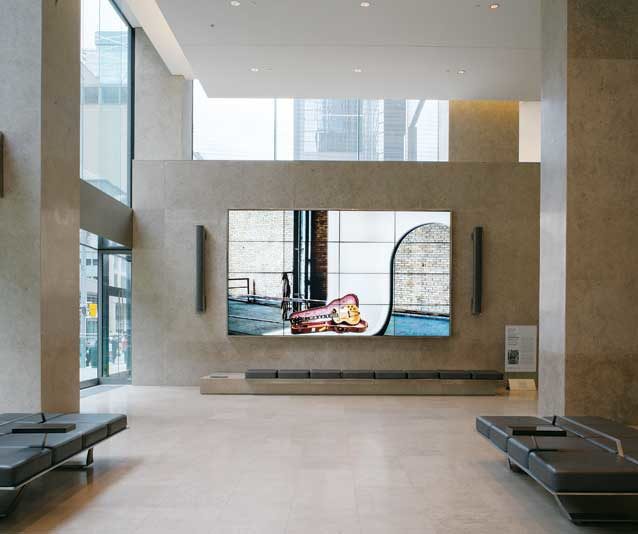The need for vinyl
The Hearn Jackman Gallery was set up on the northern side of the station in the former turbine hall, about 12 m (39 ft) above ground level and accessible by stairs and elevator.
“The main challenge was the Hearn’s designation as a heritage building,” says Tamhane. “Any application on the bricks had to be minimal and not leave behind any marks or holes. We had long discussions about our options. Initially, we were thinking about printing the photographs on an aluminum composite material (ACM) and drilling into the bricks, until we found out that was not an option! We therefore decided to go with a vinyl application, which could be installed on the walls with a bit of heat and then removed by hand.”
Fortunately, by this point, Tamhane and project co-ordinator Jeremy Forsyth had already worked with community partners—ranging from Enwave Energy to the Drake Hotel—to find locations throughout the city for the outdoor applications, including 25 of Pattison Outdoor Advertising’s local billboards, which would temporarily be filled with artwork instead of the usual ads. By working with BDI both for the public space and at the Hearn, the team ended up using the same semi-gloss vinyl from 3M Canada—specifically, Envision print wrap film LX480Cv3, along with Envision lustre wrap overlaminate 8549L—for a wide variety of placements. And as a further benefit, 3M helped sponsor the project for Luminato—which is a non-profit organization—by donating the material for the Hearn.
“That was a huge help to our project budget,” says Tamhane.

As the Hearn is a heritage building, the applications could not leave behind any marks or holes. The vinyl graphics could be installed on the walls with a little heat and removed later by hand.
“3M partners with graphics manufacturers like BDI on community projects that truly make an impact,” says Jacqui Newell, marketing planning and communications manager for 3M Canada’s commercial solutions division in London, Ont. “We were interested in the Luminato festival project because it would combine graphic wraps with a local artist’s work.”
Dotting the city
Aside from working with Pattison, the team reached out to Toronto’s various downtown business improvement areas (BIAs), which were able to recommend a list of community partners with available sites.
“We sent them information regarding the project and a request to use their external walls, with a detailed description of how each work would be installed and, finally, removed,” says Tamhane. “We had an overwhelmingly positive response, with many partners keen to participate in Luminato. As well, many were great fans of McFarland’s work. It was really through this process that we created our final list of public locations, which were dotted throughout the city from east to west.”
The wrap film was key to this process, as not only could it be conformed to textured surfaces like brick walls, but it also has been updated recently for easier removal.

Applications across the city ranged from window decals to Pattison Outdoor billboards.
Photos by Jonathan Castellino, courtesy Luminato
“The city’s walls are the perfect canvas to display this type of art installation,” says Newell. “This wrap film is one of the tools artists can use to expand their creativity in those places without disrupting the existing architecture.”
In addition to wall murals and billboards, some of the printed versions of Trove’s photos became window decals, displayed in stores. Also, the integration of digital billboards and other large-format screens—including those at the Air Canada Centre (ACC), Bank of Montreal (BMO) Field and Ricoh Coliseum sports venues—into the project meant multiple artworks could be shown dynamically in the same location.
“It would hopefully surprise those who see the images at a street corner, on the side of a building, in a shop window or on a digital billboard and make them wonder why they didn’t know all these treasures existed in their city,” says Weisbrodt.
Getting the colours correct
With the sheer scale of the project apparent, Luminato turned to BDI, which is known for handling large and complex graphic applications, to print and install the photos of Trove. This was when the 3M film was chosen, based in part on BDI’s previous experience installing outdoor photo prints using similar materials for Toronto’s annual Contact photography festival. For that matter, BDI had also worked with Luminato many times in the past.
Kelly Tsao, project manager for BDI, led the effort to produce the large-format Trove graphics on a 1.4-m (4.5-ft) wide HP Latex 360 durable aqueous inkjet printer.
“There were challenges at first in terms of getting the reproductions to match the colours of the original artworks,” says Tamhane.

Video walls and other digital signage deployments allowed multiple artworks to be showcased dynamically in the same location.
“Artists are very particular about colours, but they can’t print a large-format image themselves for us to colour-match,” Tsao explains. “So, for this project, Luminato sent us a batch of digital files. We output them with a default colour set and then they corrected them based on our output, at which point we received the files again and reprinted them.”
This process had to be repeated several times to get the colours right. To limit variations, Tsao made sure to use the same printer each time.
“We couldn’t switch machines or the colours would appear different,” he says.
The graphics for the Hearn were each 1.2 x 1.8 m (4 x 6 ft), while those designed for outdoor installation were scaled up as large as 2.4 x 2.4 m (8 x 8 ft).
“We had a sufficient schedule allotted for printing,” Tsao says, “but with the approval process, the colour corrections took up most of the time.”





